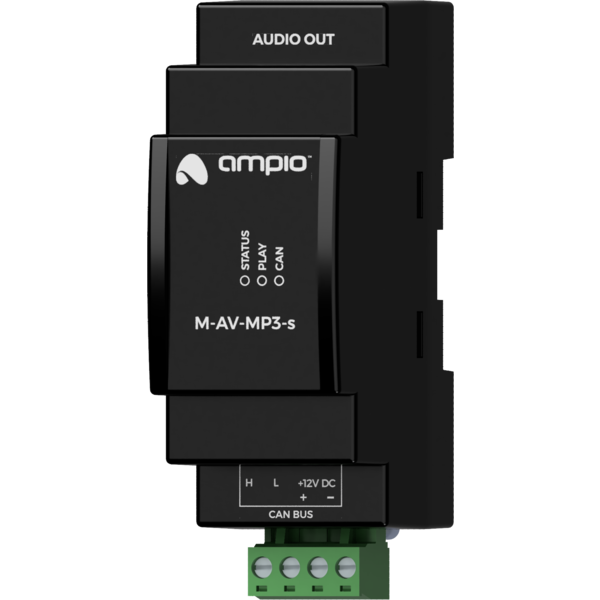
The image above is for illustration purpose only. The actual module may vary from the one presented here.
Module M-AV-MP3-s is a component of the Ampio system. Required voltage to power the module is 11 — 16V DC. The module is controlled via CAN bus.
The module allows you to play audio files from an installed microSD card. It has an audio output that can be connected to the M-AV-MP3-s bus receiver module or other power amplifier.
The audio files intended for playback by the module are stored within the microSD memory card inserted in the device. The data must be stored on a FAT32 or FAT16 partition.
The memory card installed in the module can have a maximum capacity of 32 GB.
The supported audio file formats are mp3, wav, and wma. The supported sampling rates are:
8kHz, 11.025kHz, 12kHz, 16kHz, 22.05kHz, 24kHz, 32kHz, 44.1kHz, 48kHz.
The audio files can be grouped into folders named 01, 02, … 99. If grouping is not needed,
files can be placed in the root folder of the memory card. Each folder can contain up to 255 files,
numbered from 1 to 3000.
Audio files names must be preceded by a four-digit number with leading zeros. The name of the file can consist only of that number. An example directory structure on a memory card may look like this:
Karta pamięci
├── 0020.mp3
├── 0030 Gong.mp3
├── 01
│ ├── 0001.mp3
│ ├── 0002 Song.mp3
│ ├── 0010.mp3
│ └── 3000.mp3
└── 02
├── 0001.mp3
├── 0002 Alert.mp3
└── 0003 Ring.mp3
The group identifiers (folder names) and audio file numbers defined in this way are used when
configuring the device behaviour as a part of a building automation installation. The memory card
root folder is denoted by the identifier 00.
The module is designed for mounting on a 35mm DIN rail. The module’s width is 35mm, 2 spaces/modules in DB. In order to start the module, it must be connected to the CAN bus. The bus of the Ampio system consists of four wires - two for power and two for communication between the modules.
The module is equipped with a 3.5mm TRS jack (headphone jack), which serves as a stereo line output. Use the connector to connect the device to an M-AV-AMP-s bus receiver module or other power amplifier.
Inside the module’s casing there is a microSD card slot. The SD card is used to store audio files that can later be played by the module. For instructions on how to prepare a memory card, see the chapters above.
On the front of the module there are signalling LED indicators. The green LED with the label CAN indicates the status of communication on the CAN bus:
Apart from the LED indicating the communication bus status, there are also 2 red LEDs on the front of the device:
The module is programmed with the use of the Ampio Designer software. It allows you to modify the parameters of the module and define its behaviour in response to signals directly available to the module as well as general information coming from all devices present in the home automation bus.
Dimensions expressed in millimeters.
Click to enlarge and open in a new tab.